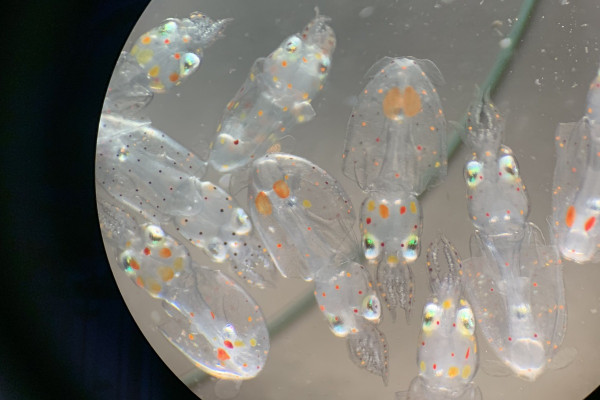
Baby squid. Photo courtesy of Owen Nichols.
By Doreen Leggett
Close to 15 years ago, after researcher Owen Nichols’ first season working with a fishing family, he came up with what he thought was an impressive chart that drew direct connections between wind direction, water temperature and the presence of squid.
He remembers being excited it to share it with Ernie Eldredge, of Chatham Fish Weirs Enterprises, whose fish weirs he was using to study squid. Eldredge looked at him with a smile and said, “My grandfather could have told you that.”
“These are things that fishermen have known for a long time,” Nichols realized.
Nichols was telling the story during a recent talk, “Squid Pro Quo: Fishermen and Scientists Working Together to Study Cephalopods from Cape Cod to the Dominican Republic,” put together for Pleasant Bay Community Boating, PBCB, as part of its speaker series.
The knowledge fishermen bring to the table is one of the main reasons Nichols is a believer in community-based fisheries research and has partnered with industry members throughout his career as director of marine fisheries research at the Center for Coastal Studies in Provincetown.
He has partnered with Eldredge on projects and the two have co-authored scientific papers.
“The value of the partnership is not just the new discoveries, it’s that fishermen and scientists are on equal footing throughout the process,” he said. “When you do it together you have a shared knowledge base, a shared belief in the findings and the process.”
His work with the Eldredge family has revealed many facts about squid, including the important role dissolved oxygen, or lack thereof, plays in squid catches. Nichols shared some of what he has learned via Zoom on a balmy May day.
This is squid season and fishermen like Eldredge and Kurt Martin, also a weir fisherman, have been bringing what people call “the ice cream cones of the sea” (because of their shape, and also because everything loves to eat them) to markets on and off Cape.
“This (talk) is about squid, but this is also very much a story about people,” Nichols said.
He explained the fishery got its start in the late 1800s, primarily for bait, and there were hundreds of vessels. But soon it became popular as food primarily harvested by trawlers.
A lot of early information on squid was gathered by Soviet scientists working on huge boats fishing just offshore, before the Magnuson Stevens Act was passed, which pushed them out 200 miles.
Squid are actually mollusks and long-finned squid (often found around here) are called bone squid because of the rigidity of the long, pen-like structure inside of them.
“They are related to clams and snails,” Nichols said.
They are one of Nichols’ favorite animals. They move in two ways (fins and propulsion), grab their prey with tentacles (in one of the fastest motions in the animal kingdom) and their eyes are similar to polarized sunglasses. Plus, they can change color and skin patterns.
“They are absolutely amazing,” he said. “I was really excited when they came out with a squid emoji.”
Squid are voracious predators, but also an important food item for many larger fish: sea bass, cod, haddock and dogfish.
“There are plenty of squid in Pleasant Bay in the summer time,” he said, adding that right now they are in Nantucket Sound, an important spawning and feeding ground.
Nichols said squid only live about a year, and the fishery is from Cape Hatteras to Cape Cod. They spawn year-round, he added, showing a video of a basketball-sized squid egg mass adjacent to a fish weir. The egg masses can be as large as a 55-gallon drum.
“When these eggs hatch they are fully developed miniature squid,” Nichols said; unlike new-born fish that generally don’t look like their adult form.
Squid typically follow a boom and bust cycle (squid landings have fluctuated from 6,700 metric tons in 2010 to 18,000 in 2016) and the last really high period was the 1980s. Decades ago, about 50 percent of the national squid catch was caught off Martha’s Vineyard and Cape Cod, but now much of the action is off Point Judith, Rhode Island.
Fishermen and scientists have also noticed a change in the type of squid prevalent in the area. There had been a preponderance of longfinned squid, but lately there has been a lot of shortfinned squid, similar to the 1970s and ‘80s.
“It is an interesting indicator of other changes in the ecosystem,” he said, but what those changes are is up for debate.
Although fish weirs used to be spread across the inshore, the bulk of squid that is now available comes from draggers offshore. Much of the work that Nichols does with fishermen is to address policy issues and make sure the fishery is sustainable. He has been interested in looking at reducing the amount of unintended catch from draggers by scaling up the traditional rod and reel method to commercial-scale jigging. Others are looking to jigging because of concerns that mobile gear will not be able to fish in areas where there are wind farms.
Nichols’ experience in community-based fisheries science earned him an invitation to the Dominican Republic in 2018 to help local scientists and small-scale fishermen build a sustainable fishery there. Locals were introduced to hook and line harvesting by the Japanese and Nichols was helping them track abundance, trends and age structure of the Diamondback Squid population.
The Diamondback Squid is huge compared to its peers off the Cape, growing to more than three feet in body length.
“Big beasts,” he said.
He is looking forward to going back (the pandemic has so far prevented his return) and doing more cooperative research with the Dominican fleet.
“Fishermen there are very much like fishermen here,” he added.
